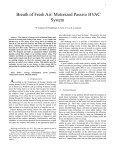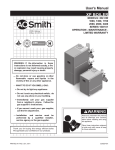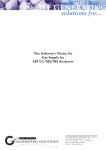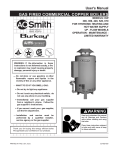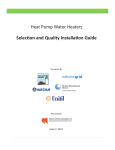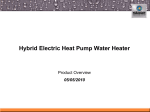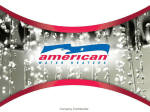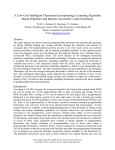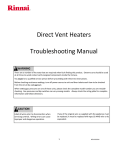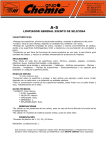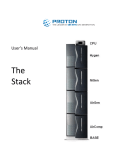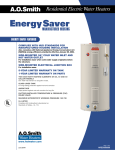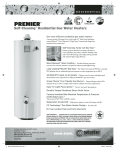Download Contractor Rewards Program - News from American Water Heaters
Transcript
Fairly extensive notes are included within this presentation. I will upload/send out this presentation in both presentation and note page format after the webinar. 1 2 3 Our models are a cost effective Eco-Friendly solution that meets all these needs and preferences. Heat pump water heaters compliment photovoltaic (solar electric panel) installations. By reducing the home’s energy consumption by 14% - 25%. Simple interest annual return on investment is 14.4% based on $360 annual Energy Guide savings and $2500 installed costs. Factoring in payback of the installed costs it is still 9.6% return. If the annual savings are $540 for a family of four per our real world estimation the simple interest annual return is 22%. Very few high risk investments will produce this level of return in today’s economy. These savings due to efficiency are high yield and low risk. According to DOE “water heating can account for 14%–25% of the energy consumed in your home.” http://www.energysavers.gov/your_home/water_heating/index.cfm/mytopic=12760 On average water heaters consume more energy than a household’s refrigerator, dishwasher, clothes washer and clothes dryer combined. They are second only to air conditioning and heating systems in household energy consumption. With greater storage capacities and EF ratings up to 2.4 our heat pump water heaters can reduce water heating costs by 66% or more without sacrificing peak demand performance. Our models are the most cost effective green technology solution to reduce household utility bills. Installed costs for our heat pump water heaters is far less than other solutions including; solar electric panels (photovoltaic), energy efficient windows, geo-thermal systems, high SEER air conditioning/heating systems, tankless or solar water heaters. 4 The Green Link box on this page has a hyperlink that will take you to the DOE’s Electric Power Monthly Excel Tables web page showing a list of links for DOE energy data. Scroll down to the “Table 5.6.A” link to download an Excel file showing the average price of electricity by state and sector; residential, commercial, industrial. The report shows average prices for May of the current year and May one year ago. Some states with higher electric rates near or above $0.15 per kWh as of May 2011: • • • • • • • • • • • Connecticut Maine Massachusetts New Hampshire Rhode Island Vermont New Jersey New York District of Columbia California Hawaii 17.96 15.32 14.77 16.44 15.75 16.04 16.37 17.58 15.18 14.76 31.7 5 Which of the following systems has the lowest installed costs and quickest payback? • Solar photovoltaic system (solar electric generation) • Geothermal • Radiant floor heating system • Double or triple pane windows • 16 SEER cooling system • 16 SEER heat pump cooling/heating system • Solar thermal water heating system • 90% gas fired forced air heating system • Our 60 and 80 gallon Hybrid Electric heat pump water heaters Our models are the most cost effective, energy saving, carbon reducing appliance on the market today. There is no better high-efficiency investment for homeowners today than one of our heat pump water heaters. 6 7 Questions for the group: 1. Why does the NAECA III (minimum 2.0 EF) requirement only target water heaters with storage capacities at or above 55 gallons? 2. Do you think NAECA will require smaller capacity electric water heaters to meet this requirement in the future? Why 3. Why did GE and Rheem introduce 50 gallon and 40 gallon models initially? 4. We introduced an 80 gallon model in May of 2010 followed by a 60 gallon model in August of 2010. What are some of the advantages of larger storage capacity heat pump water heaters? 5. What are the advantages of lower storage capacity heat pump water heaters? There are no right or wrong answers to these questions, not having an answer ok. Do not correct any answers at this point. Listen to any responses given and think about how you can tailor what you will say concerning the issue of storage as the presentation continues. The questions are presented here to get the group to start thinking about the importance of storage capacity as the presentation continues. The questions are designed to encourage group discussion about what makes sense (saves money and energy) and what doesn’t. Be prepared to ask these questions again later in the presentation and when the presentation is over to see if the group has changed their opinion concerning the advantages of larger vs smaller storage capacities. 8 According to DOE/EIA the national average price for residential electricity in January 2000 was 7.66 (cents/kwh). In June of 2011 the average price was 12.33 (cents/kWh). This is a 61% increase in the last eleven years. These numbers came from the July 2011 DOE Short Term Energy Outlook U. S. Residential Electricity Average Price report. Current data file, December 2011, has June average price slightly lower @ 12.08 (cents/kWh). Unsure why DOE changes historical data. Even with this change the current increase would be a 58% increase in residential electricity prices in the last eleven years. Calculation: new minus old divided by old - 12.08 – 7.66 ÷ 7.66 = 0.577. The Green Link box on this page has a hyperlink that will take you to the DOE’s Short Term Energy Outlook Data web page where you can download the Excel file and chart shown here. Scroll down to “Figure 24” and there is a link for the Excel file and an image file of this chart. This is valuable information the DOE compiles updates monthly. This file shows average U. S. electricity prices by month going back to January of 2000 and by year going back to 1999. 9 Share this with the group: Many electric utilities have tiered incentive programs for their load management programs. Load management programs are contractual agreements between the utility company and their customers to have a device installed that disables the heating elements in their water heaters during peak demand periods in exchange for rebates and/or lower rates. Electric utility companies typically offer lower incentives to their customers with 50 gallon water heaters while more lucrative programs are available for customers that have 80 or 120 gallon electric water heaters installed in their homes. Questions for the Group: 1. Why do electric utilities offer a more lucrative incentives for customers with larger storage capacity electric water heaters? 2. What are some of the advantages of larger storage capacity heat pump water heaters? 10 Rebates and incentive programs come and go, sometimes quickly due to limited funding. Tracking all rebates/incentives at the federal, state, local and utility company level is an enormous task. Checking one state, area or with several utility companies in your area is a manageable task. Sales representatives, distributors and installing contractors need to know what incentives are available in their areas to be successful. Encourage the group to check the rebate locator on our company web site. It should also be stressed that they check the Dsire web site regularly. Questions for the Group: 1.Are you aware of any current incentives for heat pump, solar, tankless or other high efficiency water heaters in your area? 2.How did you find out about these programs? 3.How important are incentives and rebates to a customer when choosing a high efficiency water heater? 4.Has anyone ever visited the Dsire web site? 11 The U. S. map on the DSIRE site is hyperlinked. First click on your state, this will take you to a page with a hyperlinked list of State, local and utility company incentive programs in your area. These links will in turn take you to the program web sites of the organization offering the incentive or rebate. The DSIRE web site is very easy and quick to use. Larger organizations may want to look into subscribing to customized DSIRE RSS feeds. See the My DSIRE “customize DSIRE for your organization” link in the lower left portion of the page. These RSS feeds and subscriptions are fee based services that can be tailored to suit the specific business objectives of your organization. Spreadsheets with descriptions, program details and links for new incentive programs will be sent to your designated staff member via email. This is a good way to stay informed about new incentive programs as they become available. 12 13 The heat energy in the room is already there, heat pump water heaters make use of this heat. It is more efficient to move heat from one place to another than it is to generate heat using a heating element. Installation Note: Our heat pump water heaters require a minimum of 750 cubic feet of space to ensure there will be an adequate source of heat for the refrigeration unit. Questions for the Group: 1. What areas in a home would the cool dehumidified air be a “welcome” by-product? 2. Will the cooling effect in a conditioned space save customers money on their cooling bills? 3. Will the cooling effect in a conditioned space cost customers more money during the heating season? 4. What is an ideal installation space for a heat pump water heater and why? 14 Standard electric water heaters heat water by energizing a heating element inside the storage tank. Heating elements are theoretically 100% efficient since the element is in direct contact with the water inside the storage tank. 100% efficiency would equate to an EF (Energy Factor) of 1.0. However, standard electric water heaters have EF ratings that range from about .81 to .95 due to other factors such as standby heat loss; heat escaping through the tank and jacket. Our models achieve EF ratings up to 2.4. It is much more efficient to move heat from one place to another than it is to generate heat with a heating element. Heat pump water heaters utilize a refrigeration unit with a compressor to absorb heat from the surrounding air and transfer it to the water inside the storage tank. This method of heating water requires less than one-third the electricity a standard electric water heater uses to do the same amount of heating. Not all heat pump water heaters are created equal. Heat pump water heaters equipped with higher heating capacity compressors, more efficient condensers & evaporators and MORE STORAGE will have greater efficiency, recovery and greater first hour performance.. As we will see in the product comparison portion of this presentation GE and AirGenerate products use lower capacity compressors, GE has insufficient storage at 50-gallons. They are not capable of delivering this kind of performance. And while Rheem uses a compressor of equal heating capacity Rheem models have lower storage capacities (40 and 50 gallon) and a water pump that becomes a single point of failure, a parasitic load and causes a loss of stratification in the tank which reduces efficiency, recovery and first hour performance. GE, Rheem and AirGenerate are low performing heat pump water heaters that provide the illusion of savings and performance. 15 Notes: Assumptions: the chart on this slide is based on an average stored water temperature of 104°F and a temperature rise of 90°F. Recovery rates and heating capacity for the energy saving refrigeration unit on a heat pump water heater are a moving target. They vary with ambient temperature and humidity. The higher the ambient temperature and relative humidify are in the installed space, the greater the recovery rate, heating capacity and potential for savings will be. The recovery rate examples in this slide are for our models. The recovery rates in this chart are for both of our models. Our 60 gallon and 80 gallon heat pump water heaters use the same refrigeration units. Recovery information presented here is the same for both. The ambient air temperature operational range for the refrigeration unit on our models is between 45°F and 109°F as indicated by the shaded area in the chart. The control system disables refrigeration unit operation when ambient air temperatures are outside this range and reverts to heating element operation to protect system components and to ensure the hot water demand is satisfied. 16 Notes: Assumptions: the chart on this slide is based on an average stored water temperature of 104°F and a temperature rise of 90°F. Recovery rates and heating capacity for the energy saving refrigeration unit on a heat pump water heater are a moving target. They vary with ambient temperature and humidity. The higher the ambient temperature and relative humidify are in the installed space, the greater the recovery rate, heating capacity and potential for savings will be. The heating capacity examples in this slide are for our models. The heating capacities in this chart are for both of our models. Our 60 gallon and 80 gallon heat pump water heaters use the same refrigeration units. Heating capacity information presented here is the same for both. The ambient air temperature operational range for the refrigeration unit on our models is between 45°F and 109°F as indicated by the shaded area in the chart. The control system disables refrigeration unit operation when ambient air temperatures are outside this range and reverts to heating element operation to protect system components and to ensure the hot water demand is satisfied. 17 • Compressor – the compressor is the heart (pump) of the refrigeration unit, it takes in a low pressure, low temperature vapor exiting the evaporator coil through the suction line, compresses it into a high pressure, high temperature gas and sends it to the condenser coil thorough the discharge line. • Continuous Copper Tube Condenser Coil – hot high pressure gas refrigerant flows through the condenser and transfers heat to the water inside the storage tank. The refrigerant “condenses” and changes state from a gas back to a liquid. The copper tube is continuous; there are no joints in inaccessible areas. • Thermostatic Expansion Valve – regulates the flow of liquid refrigerant from the condenser into the evaporator coil • Evaporator coil – tube and fin heat exchanger: refrigerant flowing through the tubes absorbs heat. The refrigerant “evaporates” and changes state from liquid to a vapor • Accumulator – a reservoir in the suction line upstream from the compressor that traps and prevents any liquid refrigerant that was not completely vaporized in the Evaporator Coil (during low ambient operation) from entering the compressor where it could cause damage. • Fan - draws air through the evaporator coil where heat is absorbed • Powered Anode Rod - protects the tank against corrosion - powered anode rods are maintenance free anode and will last for the life of the appliance. • User Interface Module (UIM) – Easy to use large Touch Screen LCD display with intuitive status icons, operational and diagnostic information are displayed in plain English. • Electronic Control Board – The heart of the control system. All water heater functions are controlled by the control system including; the refrigeration unit and compressor, tank temperature and monitoring and diagnostics. The control system and electronics have been designed by our electronics engineering department in McBee, SC. 18 19 20 21 Being able to explain to customers why more storage increases the savings and efficiency for heat pump water heaters requires an understanding of some basic principles of water heater sizing. The image on this slide is from our technical training department. It has been in use for decades. These principles do not change and they affect how every stored water heating system will perform. The first part of this water heater sizing principle address the balance between storage and recovery (heating capacity). The principle of Recovery + Storage = Demand must be observed when sizing a stored water heating system. If there is too little storage or not enough heating capacity the hot water demand will not be met and ultimately the customer will not be satisfied. If the principle of balancing between storage and recovery is not observed the system will not be cost effective, could result in excessive installation costs, requirements or a system that will not fit in the installed space. The second part of this sizing principle addresses time; the peak demand period(s). If the application has a short peak demand period(s), less than 3 – 4 hours as shown here, and there is enough time to reheat the stored water before the next demand begins storage should be increased, as long as there is sufficient space for higher capacity storage. Because there is sufficient time between peak demand periods, the heating capacity (recovery) can be minimized (less expensive, smaller). As long as there is enough heating capacity to bring the stored water back up to the desired system temperature before the next demand period begins the system will perform satisfactorily and be more cost effective design. If the peak demand period has a long duration, more than 3 – 4 hours, there may not be enough time to reheat the stored water between peak demand periods, there may not be enough installation space to accommodate high capacity storage that could hold a sufficient volume of water to meet the peak demand period. In this circumstance the heating capacity should be increased to accommodate the peak demand and/or the available installation space. 22 To ensure the higher efficiency refrigeration unit (compressor) provides as much of the heat used as possible AND meet the customer's peak demand (morning shower load M-F) with minimal use of the less efficient heating elements, the storage capacity must be increased. This is not an opinion, to achieve this goal it is a necessity. • More storage = more savings is not just a marketing slogan. It is the truth. • More storage = more savings is substantiated by the fundamental principles of water heater sizing; Recovery + Storage = Demand. • More storage = more savings achieves the NAECA III goal to reduce energy consumption and green house gasses by requiring minimum 2.0 EF ratings on larger capacity electric water heaters. 23 ** Our heat pump water heaters have powered anode rods that are maintenance free and will last for the life of the water heater. GE and Rheem have standard sacrificial anode rods. Standard anode rods will erode over time and rarely last 10 years. Anodes are difficult to access on heat pump water heaters. Our models utilize a powered anode that is both service and maintenance friendly. Rheem states in their installation manual: “This water heater is equipped with a non-removable anode rod designed to prolong the life of the glass lined tank. The anode rod is slowly consumed, thereby eliminating or minimizing corrosion of the glass lined tank.” GE has no maintenance instructions in their installation manual concerning their standard sacrificial anode rod. 24 Table 5-1 from the 2000 Uniform Plumbing Code (UPC). Your water heater should be equal to or exceed this rating according to UPC. DOE also recommends sizing based on this UPC code. This rating is based on the number of bedrooms and bathrooms that are located in the dwelling. Many jurisdictions require compliance with the UPC code shown here for new construction. Many engineers and architects follow UPC recommended FHR in their designs. There is a growing number of incentive programs that are also using minimum FHR recommendations of the UPC as a minimum requirement for homeowners to qualify for their incentive/rebate programs. • • • • Rheem 40 - FHR 56: GE 50 – 63 FHR: HTP 50 – 60 FHR: AirGen 50 – 63 FHR: 2 bedroom, 2 bath maximum 2 bedroom, 2 bath maximum 2 bedroom, 2 bath maximum 2 bedroom, 2 bath maximum • Rheem 50 – FHR 67: • Stiebel 80 – 78.6 FHR: • AirGen 66 – 75 FHR: 3 bedroom, 3 bath maximum 3 bedroom, 3 bath maximum 3 bedroom, 3 bath maximum • Our 60 – FHR 68: • Our 80 – FHR 84: 3 bedroom, 3 bath maximum 6 bedrooms, 3.5 bath 25 NOTE: The 80 gallon model does have a higher Energy Factor (EF) in Hybrid mode compared to Efficiency mode. This is not a typo. The 3/100ths difference between the two published EF numbers is attributed to several factors most notably: 1. The ± variance possible in any test procedure. Even though the DOE test is conducted in an environmental chamber where ambient temperature and humidity are closely maintained; if the same water heater was tested 10 times there would likely be different results though the differences would be small IE: 3/100ths. 2. As we will illustrate later in this presentation the DOE test that provides EF numbers is outdated for renewable energy products such as heat pump water heaters where slower recovery rates require more storage to allow the compressor to store lower cost heat energy that is absorbed over longer periods of time. Recovery + Storage = Demand is the first rule for sizing any water heater. Because renewable energy products have slower (lower) recovery rates more storage is a basic requirement to meet the same hot water demand a higher (faster) recovery appliance can with less storage. Tankless water heaters are an excellent example of obeying this rule of sizing, they have no storage so they typically quadruple the recovery rate to provide an adequate supply of hot water. 26 There is a misconception that the GE and Rheem models with lower storage capacities will fit in tighter places. This is not true. GE model has top water connections; water piping must observe at least 14" top clearance to allow for removal of the air filter. Rheem requires 8" top clearance to remove air filter/service. Physical height + required top clearance = Effective Height. Our air filter is removed from the side, servicing from the side. Our 60 gallon model has the lowest Effective Height compared to GE, Rheem (both sizes), HTP and both AirGenerate models also. Our 60 gallon model is the best fit for basements or any area with reduced installation height while delivering 10 – 20 gallons more hot water than GE, Rheem, HTP or AirGenerate’s 50 gallon model will. There is also a misconception that the GE model with the top water connections is easier to install. This is also not true. As shown in this illustration the GE model will require just as much “extra” plumbing to get up, over and down to the top water connections while avoiding the air filter access on top. Most integrated heat pump water heaters on the market today, 8 out of 9 models from American, Rheem, Stiebel Eltron and AirGenerate have side water connections including Rheem. The future replacement market will therefore be weighted towards models with side water connections. GE will have the most difficulty as a replacement model in the future. 27 Water lines are usually roughed in for water heaters between 56 and 64 inches from the floor in most U. S. homes. Here the shortest heat pump water heater saw no advantage due to the lowest physical height. The plumbing was roughed in at about 60” in this garage installation in Florida. Because the GE unit’s connections are on top and because it must have 14” clearances on the top for filter access the GE model required more fittings and labor to install the piping than either our 60 or 80 gallon models would have. Physical height + required top clearance = Effective Height. Our 60 gallon model has the lowest Effective Height compared to GE, Rheem (both sizes), HTP and both AirGenerate models also. Our 60 gallon model is the best fit for basements or any area with reduced installation height while delivering 10 – 20 gallons more hot water than GE, Rheem, HTP or AirGenerate’s 50 gallon model will. Because 8 out of 9 models have side water connections AND due to the extra fittings and labor required to accommodate the GE’s model with top water connections our 60 and 80 gallon models will not only have an installation advantage with the installed base in the future they have an installation advantage today with less time and fittings. 28 We performed a competitive tear down on the GE and Rheem heat pump water heaters and while the overall fit and finish of the GE unit was good there were some design issues we discovered when we removed the jacket and foam insulation. First, the condenser coil is a two piece construction with a soldered joint that is hidden behind the jacket and underneath the foam. Second, due to the small storage tank size they are forced to route the condenser tubing to the (domed) bottom of the tank that is fitted with a base ring for support. Where the condenser tube is routed through one of the openings in the base ring we discovered the condenser tube was touching the sharp metal edge of the base ring. Metal to metal contact like this in a refrigeration machine often leads to leaks. If a leak were to develop here or at the soldered joint it would be impossible to repair and the unit would have to be replaced. Our models utilize a continuous copper tube condenser. 29 Rheem’s 40 and 50-gallon units have numerous design flaws due to the type of condenser used and the presence and reliance on a water pump to transfer heat. 1. The heat exchanger on top of the unit is a concentric tube “wet” heat exchanger. If installed in garages it is prone to freeze and burst, especially if the garage door is accidentally left open for sustained periods in winter months. 2. The water pump is single point of failure and expensive to replace. If the water pump fails the compressor unit is disabled. 3. The water pump is a parasitic electrical load that reduces overall efficiency. 4. The water pump mixes water in the tank causing the loss of stratification. This raises the temperature of the water entering the heat exchanger and reduces efficiency. This also reduces delivered water temperature, customers will run out of hot water sooner and the unit will switch to the heating element operation sooner as a result. 5. Heat loss from heat exchanger on top of the tank, body of the pump and the associated water piping for the pump and heat exchanger. 30 The Rheem control system and interface is primitive and provides very little temperature control, operational or diagnostic information. The GE control system and interface is unnecessarily complex, customers are forced to locate and read the manual in order to perform the most basic adjustments such as mode of operation and set point. Error messages are displayed in codes, many of which, are not listed in the user manual. The cryptic error codes can only be interpreted using a service manual. Our models have an advanced electronic control system with a large LCD touch screen interface with intuitive icons that is visual and easy to understand. Customers do not have to locate a manual to perform common adjustments: A single touch on one of the operating mode icons at the top of display allows the customer to switch operating modes between Efficiency, Hybrid, Electric or Vacation. Temperature adjustment is just as simple and intuitive, touching the up arrow raises the temperature set point, touching the down arrow lowers the temperature set point. Our control system displays all operational information and any error messages in plain English. The control system stores the last four error messages in memory; a valuable service aid for service technicians. In short, our control system is more advanced and simpler to use than the competition! 31 32 Duct adapters can be used to redirect inlet and/or outlet air from or to other locations to permit installation in confined spaces, improve performance and maintain comfort in occupied areas of the home. Air can be drawn from or expelled to the outdoors, an attic space, or to another space inside the home. Ducting kit without booster fan: Ducting can be connected to the inlet, outlet or to both the inlet and outlet (requires both duct adapters) though the total length of duct must not exceed 10 feet. IE: when redirecting inlet and outlet air a maximum of 5 feet of inlet duct and 5 feet outlet duct is allowed. Variations such as 3/7 feet, 7/3 feet are also permitted as long as the total duct length does not exceed 10 feet. Ducting kit with booster fan: Ducting can be connected to the inlet, outlet or to both the inlet and outlet (requires both duct adapters) though the total length of duct must not exceed 25 feet. IE: when redirecting inlet and outlet air a maximum of 12.5 feet of inlet duct and 12.5 feet outlet duct is allowed. Variations such as 10/15 feet, 15/10 feet are also permitted as long as the total duct length does not exceed 25 feet. 33 Installation Considerations The compressor unit on the water heater is disabled when the temperature of the air flowing to the inlet is lower than 45°F (7.2°C) or higher than 109°F (42.8°C). Air expelled from the outlet will be 7°F to 9°F (4°C to 5°C) cooler than the inlet air. These operational parameters must be considered when determining if a location to duct inlet air from will be suitable. IMPORTANT NOTE: If the compressor unit is disabled for long periods of time due to inlet air temperature being too hot or too cold the potential energy savings a heat pump water heater is able to provide may be significantly reduced. Air Inlet • Outdoor air temperatures will often be lower than 45°F (7.2°C) in many regions during fall and winter months. • Attic temperatures will often exceed 109°F (42.8°C) in many regions during spring and summer months. • Ducting outdoor air to the air inlet of the unit may place additional load on the cooling system in the summer months. The air expelled from the outlet will be 7°F to 9°F cooler than the inlet air, if the outdoor air temperature is > 90°F (27°C) the unit would add heat to the home during the cooling season. • Air being drawn from an alternate location inside the home may cause a negative pressure condition inside that area. As a result cold or hot air from outdoors may be drawn into the structure and place additional load on the space heating and cooling equipment. Air Outlet • Cold air blowing from the outlet into an alternate location inside the home may cause cooling discomfort and be objectionable. • Cold air blowing from the outlet into an alternate location inside the home may place additional load on space heating equipment during fall and winter months. • Ducting outlet air only to an alternate location may cause a negative air pressure in the installed space. As a result cold or hot air from outdoors may be drawn into the structure and place additional load on the space heating and cooling equipment 34 35 36 Energy Guide estimated annual operating costs are calculated based on DOE Energy Factor testing. Energy Guide FHR ratings are based on DOE FHR tests. Given what we have presented so far a good question would be how can “More Storage = More Savings” be true if GE’s 50-gallon heat pump water heater has lower operating costs according to the Energy Guide/DOE testing? The answer is in the differences between real world usage and the DOE test protocols. The following slides will illustrate and explain these differences. Energy Guide annual operating costs for major brands: • GE 50-gallon: $198 • Our 60-gallon: $201 • Our 80-gallon: $201 • Rheem 40-gallon: $234 • Rheem 50-gallon: $234 37 The DOE Energy Factor (EF) test (also known as the 24 hour test) is performed by drawing 64.3 gallons of water divided into 6 equal draws (10.71 gallons each). The six draws of water are taken at the beginning of each of the first six hours of the test. During the remaining 18 hours standby heat loss is measured. Efficiency based on this draw profile and heat loss are calculated to deliver the Energy Factor (EF). The annual estimate operating costs shown on the yellow Energy Guide labels are also based on this DOE test protocol. Things to consider: 1. One of these 10.71 gallon draws does not amount to the DOE’s own estimated average of 12 gallons per shower. The hyperlink in the green box on this slide will direct you to the DOE web site where this information is given. 2. The pattern of 6 draws equally spaced during a six hour period does not match any real world residential draw profile. 3. The estimated operating costs shown on the yellow Energy Guides are based on this EF test. 4. Given the above, are EF ratings and Energy Guide labels a good indicator of what real world operating costs or potential savings will be? 38 On this graphic the blue field represents a four shower (12 gallon per shower) load during a 90 minute period. This 90 minute period is a typical duration for a residential peak demand period. Residential peak demand usually occur between 5:30 and 8:00 AM Monday through Friday for most homeowners in North America. The blue field shows a total gallons used of 48 gallons of hot water and is based on the DOE’s estimated average of 12 gallons per shower. Is this profile an accurate representation of a real world draw profile? Five parameters need to be considered to determine how many gallons of hot water will be used during a shower. 1. 2. 3. 4. 5. Cold water supply temperature Stored hot water temperature Mixed water temperature Flow rate of mixed water Duration of the shower 39 In these two examples a 10-minute shower would use 14 to 17 gallons of hot water. However there are 4 variables that can and will cause that same 10minute shower to consume more hot water. Consider the following questions: 1. What will average gallons per shower be if the customer sets his thermostat to the manufacturer recommended 120°F? 2. What will average gallons per shower be if the customer takes a 15 minute shower? (children particularly teenagers take longer showers) 3. What if the customer has a larger garden tub, 5 GPM shower heads or multiple fixtures in their shower? 4. What will average gallons per shower be if the average cold water temperature is below 60°F during fall and winter months? 5. In a real world situation, how often will at least one of the four conditions above be a factor? Conclusion; test protocols used by DOE is not based on real world residential peak demands. 40 Here we can see that over two thirds of the country’s average ground water temperature is under 60°F and about a half the country’s average ground water temperature is 52°F or less. Proper water heater sizing requires that the average ground water temperature be considered. 41 On this graphic the blue field represents a four shower (17 gallon per shower) load during a 90 minute period. This 90 minute period is a typical duration for a residential peak demand period. Residential peak demands usually occur between 5:30 and 8:00 AM Monday through Friday for most homeowners in North America. The blue field shows total gallons used of 68 gallons of hot water and is based on customers who have 3 GPM shower heads, take 10-minute showers with an average ground water temperature of 60°F. If the average ground water temperature was 50 degrees as it is in nearly half of the United States, a 3.0 GPM shower heat would use 18 gallons of hot water for the same 10 minute showers and the total gallons used during the peak demand would be 72 gallons. 42 In this example there is a $250 dollar federal tax rebate and a local utility company rebate of $700. Payback occurs in 2.1 years. Keep in mind the $360 (and the total life savings of $4,320) is based on $0.10 per kWh and DOE based Energy Factor testing which we have already demonstrated greatly underestimates the advantages of larger storage capacities. The savings estimate here is not based on real world usage but on the DOE Energy Factor (24 hour) test. 43 In this example there is a $250 dollar federal tax rebate and a local utility company rebate of $350. Payback occurs in 3.1 years. Keep in mind the $360 (and the total life savings of $4,320) is based on $0.10 per kWh and DOE based Energy Factor testing which we have already demonstrated greatly underestimates the advantages of larger storage capacities. The savings estimate here is not based on real world usage but on the DOE Energy Factor (24 hour) test. 44 In this example there are no incentives. However, there is a 14.4% annual return on the investment and life savings of $4,320. Keep in mind the $360 (and the total life savings of $4,320) is based on $0.10 per kWh and DOE based Energy Factor testing which we have already demonstrated greatly underestimates the advantages of larger storage capacities. The savings estimate here is not based on real world usage but on the DOE Energy Factor (24 hour) test. 45 In this example there are no still no incentives. The savings are now based on a real world peak demand for a family of four at $540. The annual return on the original $2,500 investment is now at 22% ($540 ÷ $2,500 = 22%) and the life savings has increased to $6,480. We estimate annual savings to be $540 for a family of four based on based on $0.10 per kWh and a real world draw profile. This reduces the payback period to 3.1 years without any incentives. Another significant factor to consider; these calculations do not include Energy Inflation. As we have seen earlier in the presentation the average price of electricity in the United States has increased by 58% to 61% since January of 2000, an 11 year period. Both the annual operating costs savings and the lifetime (12 year) product savings will be significantly increased if energy inflation is factored in. 46 47 All three of these tests are available to the public. Both our 60 and 80 gallon models out performed all the competitor models in all three independent tests. The BPA test is the most telling of the three. The summary slides for this test validate the fact that larger storage capacity models will deliver greater efficiency, savings and more hot water. 48 49 Notice that our 60-gallon model delivers the highest EF ratings of all three major manufacturers in all test conditions. Hybrid mode is used during the standard DOE Energy Factor (24 hour) test. The other three test conditions are used to test performance under various operating conditions as described in the chart. Notice here that the Rheem unit’s EF test result in the Hybrid mode is only 1.5. Rheem has the lowest efficiency and EF of all three major brands. The Rheem model does not achieve their published 2.0 Energy Factor in Hybrid mode under standard DOE test conditions. The Rheem unit Energy Factor performance falls short of our 60-gallon model for three main reasons: 1. The parasitic load of the water pump 2. The water pump mixes water in the tank causing the loss of stratification, which reduces the ability of the compressor to add heat to the stored water. 3. Heat loss from heat exchanger on top of the tank, body of the pump and the associated water piping for the pump and heat exchanger. Rheem delivers the illusion of savings and performance. Our models deliver greater efficiency, greater savings and more hot water. 50 Looking at these results may indicate why GE and Rheem do not want to publish FHR in all operating modes. Our 60-gallon model far outperforms both models. Our 80-gallon model would widen this difference even further. Note GE with a 36 gallon FHR in Efficiency mode. If the customer sets the mode to Efficiency they will likely be disappointed during their peak demand. They will run out of hot water. Notice how the GE model FHR jumps to 57/58 when placed in the Hybrid mode. This boost in FHR is most likely due to the resistive heating elements being used. The blue column already demonstrates the limitations of their 700 watt compressor (our models have an 850 watt compressor that has significantly more heating capacity). GE delivers the illusion of savings and performance. Our models deliver greater efficiency, savings and more hot water. 51 52 The liters/draw for the test draw beginning at 8:50 (20:50 military time) shows 45.42 liters drawn. This is obviously a typo in the report. The correct draw for this 1.9 lit/min flow rate one minute draw would be 1.9 liters. The liters drawn for the bath draw that begins at 19:50 is also a typo. This one should be 45.6 liters, 11.4 lit/min flow for 4 minutes = 45.6 liters. We will focus on the four shower morning segment of this test later in the presentation. 53 The NREL DP2 test is a series of twelve 1 minute and sixteen 30 second draws over a 5 hour and 45 minute period. The total usage is 75.71 liters (20 gallons). As we will see in the next slide this draw profile heavily favors models with lower storage capacities. However, there is no real world residential hot water draw profile that resembles this test. NREL’s explanation for the DP2 draw profile in the report: “Draw Profile 2 consisted of many short draws and was allowed to run uninterrupted. Depending on tank size and recovery rate, these draw profiles have the potential to deplete the hot water reserve, resulting in warm or even cold water being delivered to the users.” 54 This table shows the morning segment of the NREL test DP1 draw profile adding gallons and GPM conversions. Notice shower #2, being only 5 minutes. This short shower draw in effect favors the lower gallon capacity models tested from GE and Rheem. By lowering the #2 shower duration to only 5 minutes the 50 gallon models tested will not be as likely to resort to heating elements AND the maintain a delivered water temperature at 105 degrees longer. In the test commissioned by BPA we will look at in later slides the shower load was 68 gallons over 90 minutes. In that test the GE and Rheem models did not perform well and it is noted in the summary. 55 While it could be argued that the DPI test conducted by NREL was still not a real world draw profile, it is certainly much better than the DOE 24 hour EF test. Notice how Units A and D (the 80-gallon units) COP ratings are much better than the other models during the DP1 morning and evening tests. This is further validation that models with larger storage capacities will use the compressor more frequently than models with lower storage capacities, especially under peak demand loads. Also keep in mind what we learned about real world peak demands earlier in this presentation. A typical family of four taking four 10 minute showers in a 90 minute period will consume 68 gallons of hot water. If the showers are longer or the average ground water temperature is lower the gallons used would be greater than 68 gallons. The total gallons used for NREL’s “high demand” DP1 morning test was 64 gallons. While we are grateful to NREL for conducting a four shower test during one hour, a significant improvement compared to the DOE’s Energy Factor (24 hour) test, the NREL test still falls short of what a real world (family-of-four) peak demand would be. Also notice that, as the draw loads decrease, the COP of units with smaller storage capacities improve; they are more efficient under light loads and less efficient under peak demands. The DP2 draw profile certainly favors models with lower storage capacities as shown in this chart. However, the DP2 test (twelve 1 minute and sixteen 30 second draws over a 5 hour and 45 minute period – 20 gallons total) is abstract. There is no correlation between the DP2 test and the way homeowners use hot water. 56 In the NREL test protocol information on page 4 of the NREL report they state that the decision was made to conduct the FHR tests following the DOE test standards but to also conduct the test at two other tank set point temperatures to evaluate the models being tested under a range of conditions. Notice in the chart that the report only shows FHR test results for the GE model at the DOE standard 60C (140F) set point. Test results for all three set point conditions are shown for all other brands. Also notice GE’s FHR results are less than their published FHR on their specification sheets and other marketing collateral. Compare the NREL FHR test results for the various brands to the UPC First Hour Recovery standard for proper sizing. In this test we were the only manufacturer to out perform our published rating and we did under all test conditions. This would hold true for our 60 gallon model also. 57 This slide illustrates the advantage storage capacity has in maintaining minimum of 105° outlet water temperature. Notice how both of the 80 gallon models perform compared to the lower capacity models. 58 BPA study was aimed at pacific northwest cooler climate conditions. During this testing, also conducted by NREL, they conducted two draw profiles DP2 segment 1: 4 shower draw profile over 90 minutes totally 68 gallons. Average shower – 17 gallons hot water. DP2 segment 2: various draws over 4 hour period totaling 40 gallons. Our 80-gallon model completed four 17 gallon showers in a 90 minute period without resorting to heating elements or outlet water temperature dropping below 105F. This was a real world test that confirms More Storage = More Savings. 59 BPA study was aimed at pacific northwest cooler climate conditions. Comment from page 19 of the online report summary linked below: “larger storage capacity of 75 gallons reduces element use” (75 gallons is actual measured gallons. IE: GE and Rheem “50” gallon models are 45 gallons) Here BPA findings state: There is a link between storage capacity and overall efficiency. This validates our “More Storage = More Savings” claim. The circulation pump that Rheem uses will cause problems for customers. The destratification of the tank will cause lower delivery temperatures and reduce compressor efficiency. That both GE and Rheem with the lower capacity storage will result in more element usage which diminishes efficiency. 60 Keys to increase sales and market share: • Remember: higher temperatures & humidity, higher electric rates and higher demands. • Know who your target customers are. • Keep up with rebates and incentives in your area, be the first to know about incentives and rebates in your area. • Compile a payback information factoring in, electric rates, savings, incentives. Compare our heat pump water heater to other high efficiency appliances to help customers understand these products are the most cost effective high efficiency products on the market today with the quickest payback. • Bother to be an expert, know more about this product category than the sales representatives for the competition. You will not only be more successful with our products but you will also be more successful with your other product lines. 61 62































































